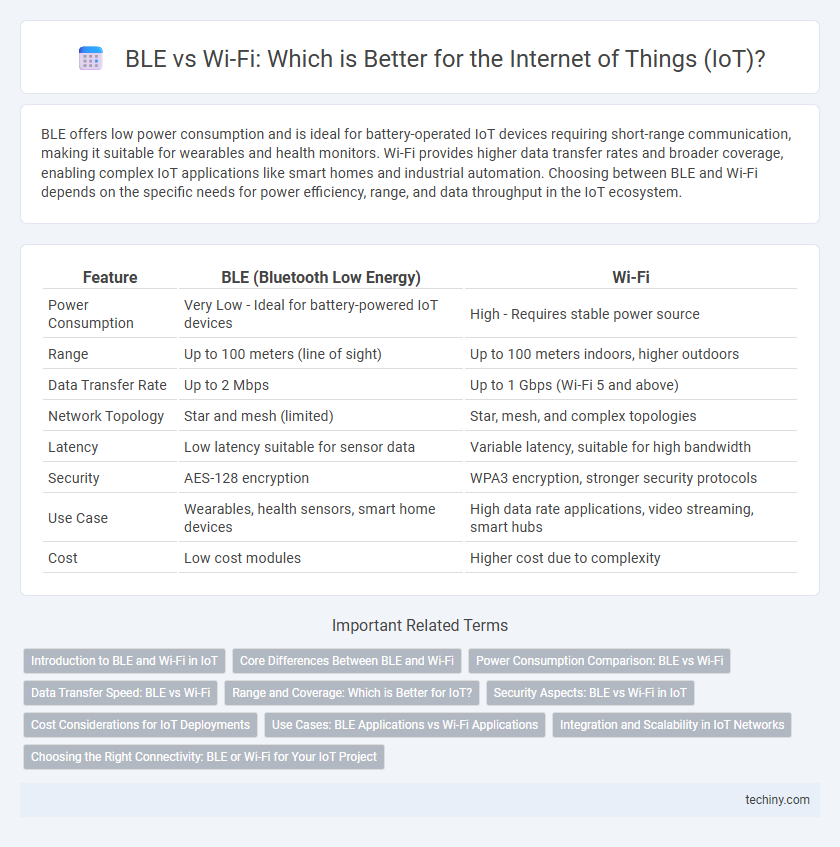BLE offers low power consumption and is ideal for battery-operated IoT devices requiring short-range communication, making it suitable for wearables and health monitors. Wi-Fi provides higher data transfer rates and broader coverage, enabling complex IoT applications like smart homes and industrial automation. Choosing between BLE and Wi-Fi depends on the specific needs for power efficiency, range, and data throughput in the IoT ecosystem.
Table of Comparison
| Feature | BLE (Bluetooth Low Energy) | Wi-Fi |
|---|---|---|
| Power Consumption | Very Low - Ideal for battery-powered IoT devices | High - Requires stable power source |
| Range | Up to 100 meters (line of sight) | Up to 100 meters indoors, higher outdoors |
| Data Transfer Rate | Up to 2 Mbps | Up to 1 Gbps (Wi-Fi 5 and above) |
| Network Topology | Star and mesh (limited) | Star, mesh, and complex topologies |
| Latency | Low latency suitable for sensor data | Variable latency, suitable for high bandwidth |
| Security | AES-128 encryption | WPA3 encryption, stronger security protocols |
| Use Case | Wearables, health sensors, smart home devices | High data rate applications, video streaming, smart hubs |
| Cost | Low cost modules | Higher cost due to complexity |
Introduction to BLE and Wi-Fi in IoT
Bluetooth Low Energy (BLE) and Wi-Fi are two pivotal wireless communication technologies in the Internet of Things (IoT) ecosystem, each optimized for different use cases. BLE offers low power consumption and is ideal for short-range, sensor-driven applications like wearable devices and smart home gadgets, facilitating prolonged battery life. Wi-Fi provides higher data throughput and broader range, making it suitable for bandwidth-intensive IoT applications such as video surveillance and smart appliances requiring constant internet connectivity.
Core Differences Between BLE and Wi-Fi
BLE (Bluetooth Low Energy) excels in ultra-low power consumption and short-range connectivity, ideal for battery-powered IoT devices requiring intermittent data transmission. Wi-Fi offers higher data rates and broader coverage, supporting continuous, high-bandwidth applications and seamless integration with existing IP networks. Core differences include BLE's optimized energy efficiency versus Wi-Fi's superior throughput and network scalability.
Power Consumption Comparison: BLE vs Wi-Fi
Bluetooth Low Energy (BLE) consumes significantly less power than Wi-Fi, making it ideal for battery-operated IoT devices requiring extended operation. BLE typically uses only a few milliwatts during data transmission, whereas Wi-Fi can consume up to several hundred milliwatts, leading to faster battery drain. This power efficiency difference makes BLE preferable for sensors and wearables that transmit small data packets intermittently over long periods.
Data Transfer Speed: BLE vs Wi-Fi
Wi-Fi offers significantly higher data transfer speeds than BLE, typically ranging from 54 Mbps in older standards to over 1 Gbps in the latest Wi-Fi 6 and 6E protocols, enabling rapid transmission of large data files. BLE (Bluetooth Low Energy) is optimized for low power consumption with data rates generally up to 2 Mbps in BLE 5.0, making it suitable for small, intermittent data packets in IoT devices. For applications requiring frequent, high-volume data transfer such as video streaming or real-time analytics, Wi-Fi is preferable, while BLE excels in low-bandwidth sensor data communication and prolonged battery life scenarios.
Range and Coverage: Which is Better for IoT?
Bluetooth Low Energy (BLE) typically offers a range of up to 100 meters, making it suitable for close-proximity IoT applications with low power consumption. Wi-Fi provides a significantly broader coverage range, often exceeding 100 meters indoors and extending further outdoors, ideal for IoT devices requiring high data throughput and wider area connectivity. Choosing between BLE and Wi-Fi depends on specific IoT use cases prioritizing either extended coverage or energy efficiency.
Security Aspects: BLE vs Wi-Fi in IoT
BLE offers enhanced security features like frequent key refresh and lower exposure to interference, making it ideal for short-range IoT applications requiring secure device pairing. Wi-Fi provides robust encryption protocols such as WPA3, supporting stronger authentication and data protection suitable for complex IoT networks with higher data throughput. Both technologies implement security measures, but BLE's limited range reduces attack surfaces, while Wi-Fi's broad coverage demands more advanced intrusion detection systems.
Cost Considerations for IoT Deployments
BLE (Bluetooth Low Energy) offers a lower-cost solution for IoT deployments due to its reduced power consumption and simpler hardware requirements compared to Wi-Fi, which typically incurs higher expenses due to more complex chipsets and increased energy needs. BLE modules are generally cheaper and extend battery life, making them ideal for large-scale sensor networks where cost-efficiency is critical. Wi-Fi provides higher data throughput but increases deployment and operational costs, impacting budget-sensitive IoT projects.
Use Cases: BLE Applications vs Wi-Fi Applications
BLE excels in low-power, short-range IoT applications such as fitness trackers, smartwatches, and proximity sensors, enabling efficient device-to-device communication with minimal energy consumption. Wi-Fi supports high-bandwidth, long-range IoT use cases like smart home hubs, surveillance cameras, and industrial automation systems, offering reliable internet connectivity and robust data transfer. Selecting BLE or Wi-Fi depends on application requirements for power efficiency, range, and data throughput in IoT deployments.
Integration and Scalability in IoT Networks
BLE offers seamless integration in IoT networks with low power consumption, making it ideal for battery-operated devices and short-range communication. Wi-Fi supports higher data throughput and broader coverage, facilitating scalability for extensive IoT deployments requiring robust connectivity. Selecting BLE or Wi-Fi depends on device density, power constraints, and network size within IoT ecosystems.
Choosing the Right Connectivity: BLE or Wi-Fi for Your IoT Project
BLE offers low power consumption ideal for battery-operated IoT devices with limited data transmission needs, while Wi-Fi provides higher data rates and broader range suitable for applications demanding continuous connectivity and larger data payloads. Selection between BLE and Wi-Fi hinges on factors such as power efficiency requirements, data volume, latency sensitivity, and network infrastructure compatibility. For sensor networks and wearable tech, BLE is optimal; for smart home hubs and video streaming IoT devices, Wi-Fi often delivers superior performance.
BLE vs Wi-Fi Infographic

 techiny.com
techiny.com